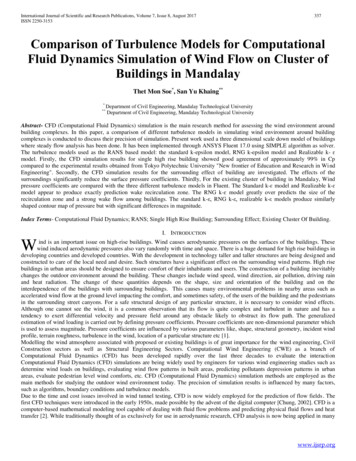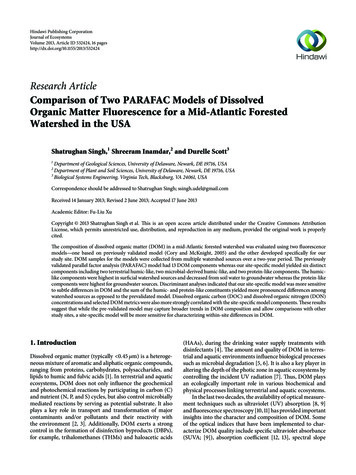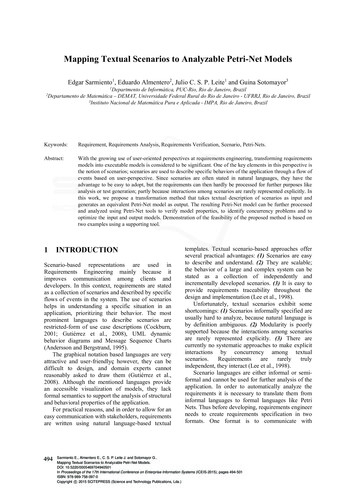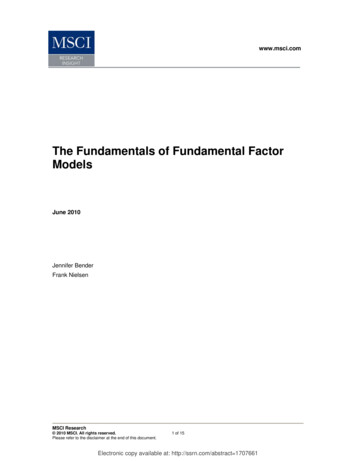
Transcription
International Journal of Scientific and Research Publications, Volume 7, Issue 8, August 2017ISSN 2250-3153337Comparison of Turbulence Models for ComputationalFluid Dynamics Simulation of Wind Flow on Cluster ofBuildings in MandalayThet Mon Soe*, San Yu Khaing*****Department of Civil Engineering, Mandalay Technological UniversityDepartment of Civil Engineering, Mandalay Technological UniversityAbstract- CFD (Computational Fluid Dynamics) simulation is the main research method for assessing the wind environment aroundbuilding complexes. In this paper, a comparison of different turbulence models in simulating wind environment around buildingcomplexes is conducted to discuss their precision of simulation. Present work used a three dimensional scale down model of buildingswhere steady flow analysis has been done. It has been implemented through ANSYS Fluent 17.0 using SIMPLE algorithm as solver.The turbulence models used as the RANS based model: the standard k-epsilon model, RNG k-epsilon model and Realizable k- ɛmodel. Firstly, the CFD simulation results for single high rise building showed good agreement of approximately 99% in Cpcompared to the experimental results obtained from Tokyo Polytechnic University "New frontier of Education and Research in WindEngineering". Secondly, the CFD simulation results for the surrounding effect of building are investigated. The effects of thesurroundings significantly reduce the surface pressure coefficients. Thirdly, For the existing cluster of building in Mandalay, Windpressure coefficients are compared with the three different turbulence models in Fluent. The Standard k-ɛ model and Realizable k-ɛmodel appear to produce exactly prediction wake recirculation zone. The RNG k-ɛ model greatly over predicts the size of therecirculation zone and a strong wake flow among buildings. The standard k-ε, RNG k-ε, realizable k-ε models produce similarlyshaped contour map of pressure but with significant differences in magnitude.Index Terms- Computational Fluid Dynamics; RANS; Single High Rise Building; Surrounding Effect; Existing Cluster Of Building.I. INTRODUCTIONWind is an important issue on high-rise buildings. Wind causes aerodynamic pressures on the surfaces of the buildings. Thesewind induced aerodynamic pressures also vary randomly with time and space. There is a huge demand for high rise buildings indeveloping countries and developed countries. With the development in technology taller and taller structures are being designed andconstructed to care of the local need and desire. Such structures have a significant effect on the surrounding wind patterns. High risebuildings in urban areas should be designed to ensure comfort of their inhabitants and users. The construction of a building inevitablychanges the outdoor environment around the building. These changes include wind speed, wind direction, air pollution, driving rainand heat radiation. The change of these quantities depends on the shape, size and orientation of the building and on theinterdependence of the buildings with surrounding buildings. This causes many environmental problems in nearby areas such asaccelerated wind flow at the ground level impacting the comfort, and sometimes safety, of the users of the building and the pedestriansin the surrounding street canyons. For a safe structural design of any particular structure, it is necessary to consider wind effects.Although one cannot see the wind, it is a common observation that its flow is quite complex and turbulent in nature and has atendency to exert differential velocity and pressure field around any obstacle likely to obstruct its flow path. The generalizedestimation of wind loading is carried out by defining pressure coefficients. Pressure coefficients are non-dimensional parameter whichis used to assess magnitude. Pressure coefficients are influenced by various parameters like, shape, structural geometry, incident windprofile, terrain roughness, turbulence in the wind, location of a particular structure etc [1].Modelling the wind atmosphere associated with proposed or existing buildings is of great importance for the wind engineering, CivilConstruction sectors as well as Structural Engineering Sectors. Computational Wind Engineering (CWE) as a branch ofComputational Fluid Dynamics (CFD) has been developed rapidly over the last three decades to evaluate the interactionComputational Fluid Dynamics (CFD) simulations are being widely used by engineers for various wind engineering studies such asdetermine wind loads on buildings, evaluating wind flow patterns in built areas, predicting pollutants depression patterns in urbanareas, evaluate pedestrian level wind comforts, etc. CFD (Computational Fluid Dynamics) simulation methods are employed as themain methods for studying the outdoor wind environment today. The precision of simulation results is influenced by many factors,such as algorithms, boundary conditions and turbulence models.Due to the time and cost issues involved in wind tunnel testing, CFD is now widely employed for the prediction of flow fields. Thefirst CFD techniques were introduced in the early 1950s, made possible by the advent of the digital computer [Chung, 2002]. CFD is acomputer-based mathematical modeling tool capable of dealing with fluid flow problems and predicting physical fluid flows and heattransfer [2]. While traditionally thought of as exclusively for use in aerodynamic research, CFD analysis is now being applied in manywww.ijsrp.org
International Journal of Scientific and Research Publications, Volume 7, Issue 8, August 2017ISSN 2250-3153338other fields, including marine engineering, electrical and electronic engineering, biomedical engineering, chemical engineering,environmental engineering, wind engineering, hydrology, oceanography, meteorology, and nuclear power [2].In this journal, the wind pressure characteristics are investigated with the following three cases:(1) A single high rise building case is first considered with three different turbulence models and is compared with the experimentalresults obtained from Tokyo Polytechnic University “New frontier of Education and Research in Wind Engineering”, to explain themethod used to validate our CFD simulations.(2) And then, a high rise building with surrounding buildings cases are investigated to predict wind characteristics of the flow field.(3) Finally, existing cluster of buildings case is considered with CFD simulation by using ANSYS Fluent to predict wind pressurecoefficients and wind pressure distributions with height on the L-shape building and to investigate the flow path of the velocitydistributions within actual existing cluster of buildings in Mandalay.II. METHODOLOGYWhen performing a simulation, the user typically chooses target variables, the approximate form of the governing equations, theturbulence model, the level of detail in the geometrical representation of the buildings, the size of the computational domain, the typeand resolution of the computational grid, the boundary conditions, the discretization schemes, and the iterative convergence criteria.A. Computational Fluid DynamicsModeling the wind atmosphere associated with proposed or existing buildings is of great importance for the wind engineering, CivilConstruction sectors as well as Structural Engineering Sectors. Computational Wind Engineering (CWE) as a branch ofComputational Fluid Dynamics (CFD) has been developed rapidly over the last three decades to evaluate the interactionComputational Fluid Dynamics (CFD) simulations are being widely used by engineers for various wind engineering studies such asdetermine wind loads on buildings, evaluating wind flow patterns in built areas, predicting pollutants depression patterns in urbanareas, evaluate pedestrian level wind comforts, etc. Numerical simulations are more flexible and robust in terms of simulating windflow conditions together with detailed surrounding features such as buildings, mountains, tree, etc. CFD techniques have been adoptedfor the estimation of wind flow around building. Progress in high-speed processing by personal computer and rapid propagation ofsoftware for numerical analysis of fluid dynamics in recent years have enabled prediction of the pedestrian wind environment aroundhigh-rise buildings based on CFD. CFD simulations would be a smart tool for practicing engineers to analyses wind conditions invicinity of a high-rise building.In Myanmar, wind engineering is not as much as developed compared the other branches of civil engineering. Nowadays, the concernof wind engineering is increasing among Myanmar engineers due to increase of damages due to frequent occurrence of high windevents and construction of many high-rise buildings in city center, which are more susceptible to wind load. Environmentally, wind,sunlight, natural light, air, noise, skyline, landscape and traffic are the major physical factors that are affected from high-rise existence.These parameters affect quality of life and the conditions under which people live and work. The use of natural ventilation is highlyconstrained by its surrounding environments. The sheltering effect of the surrounding built-up environment can reduce pressuredifferences across a building which is necessary to produce adequate ventilation rates.Computational Fluid Dynamics (CFD) represents the science and methodology of predicting fluid flow by solving governingequations using a numerical algorithm and necessary empirical models. CFD was made possible with the advent of the computer andis continually benefited by increased processor speeds and memory allowance. There are three main components to theimplementation of CFD methodology: grid generation, algorithm development, and turbulence / empirical modeling. Grid generationrefers to segregating the flow domain into individual cells or elements. The grid is used to calculate derivatives and fluxes for thenumerical algorithm. The numerical algorithm refers to how the derivatives and fluxes are calculated i.e. central differenced or upwinded and order of accuracy etc. Models are used to reduce computational requirements (such as processor speed and memory)involved in resolving turbulent flow.B. Governing equationsWind engineers study more about the lower part of the atmosphere though entire earth atmosphere extends few kilometers above theearth surface. This lower part of the atmosphere is called as atmospheric boundary layer (ABL), which is directly under influence ofearth surface itself such as shape, friction, thermal with time scales of less than a day and turbulent motion length scales of the order ofboundary layer depth [3]. This boundary layer depth can be varying from several hundred meters to more than a kilometer aloft. Thus,most of manmade structures are well within the atmospheric boundary layer, governing flow equations can apply in this layer easily.However, both time and length scales of atmospheric flows have large variations. Thus, numerical simulations are divided in to microscale and meso-scale based on time and length scale for easiness of study. In this study, term CFD simulation is strictly used todescribe the simulation of smaller length ( 10 cm - 100 m ) and time scales ( 1 minute – 1 hour), thus probably in the category ofmicro-scale modelling. Most of governing equations in fluid dynamics can be applied to the atmospheric flows. The main governingequations are about conservation of mass (equation 1) and momentum (equation 2). The latter is also known as Navier-Stokesequation for motion of the fluid.www.ijsrp.org
International Journal of Scientific and Research Publications, Volume 7, Issue 8, August 2017ISSN 2250-3153 t ui t ( ui ) xi 0 ( ui u j ) x j339(1) P xi ui u j x j x j xi (2)Where, ui, uj are velocity components, ρ is air density, P is air pressure, μ is dynamic viscosity, and t is time. In this equation, Coriolisforce and buoyance force are not considered as their effect is negligible in smaller length and time scale, which is valid for micro-scaleCFD simulations.C. Turbulence ModelsTurbulence modeling is the computational procedure to solve and analyze the fluid flow introducing some approximations in thegoverning differential equations so that required solution is obtained approximately consuming feasible computational memory andtime. Turbulence modeling is based on the assumption that the real flow field may be substituted by an imaginary field ofmathematically defined continuous functions. The objective of the turbulence modeling is to develop a set of constitutive relationsvalid for any general turbulent flow problem which yield sufficiently reliable predictions and offer a degree of universality sufficientto justify their usage in terms of computational effort and accuracy. Many turbulence modeling techniques deal with an approximationto the Navier-Stokes equations in form of averaging the different ranges of turbulent eddy scales. For prediction of turbulent flows, theavailable approaches of turbulence modeling are (i) Direct Numerical Simulation (DNS) (ii) Large Eddy Simulation (LES) (iii)Reynolds Averaged Navier Stokes solution (RANS). The most common approach in CWE is RANS. Therefore, this section focuseson the turbulence models used in RANS. The equations of the RANS models calculate the transport equations only for the averagequantities of the air flow, for which all the turbulence scales are simulated. By the early 1950's, four main categories of turbulencemodels had developed:(1) Algebraic (Zero-Equation) Models(2) One-Equation Models(3) Two-Equation Models(4) Second-Order Closure ModelsWith increased computer capabilities beginning in the 1960's, further development of all four of these classes of turbulence models hasoccurred.Among them, Two-equation models have been the most popular models for a wide range of engineering analysis and research. Thesemodels provide independent transport equations for both the turbulence length scale, or some equivalent parameter, and the turbulentkinetic energy. With the specification of these two variables, two-equation models are complete; no additional information about theturbulence is necessary to use the model for a given flow scenario. While this is encouraging in that these models may appear to applyto a wide range of flows, it is instructive to understand the implicit assumptions made in formulating a two-equation model.Specifically, most two-equation models make the same fundamental assumption of local equilibrium, where turbulent production anddissipation balance. This assumption further implies that the scales of the turbulence are locally proportional to the scales of the meanflow; therefore, most two equation models will be in error when applied to non-equilibrium flows. Though somewhat restricted, twoequation models are still very popular and can be used to give results well within engineering accuracy when applied to appropriatecases [4].The K-epsilon model is one of the most common turbulence models. It is a two equation model, which means, it includes two extratransport equations to represent the turbulent properties of the flow. This allows a two equation model to account for history effectslike convection and diffusion of turbulent energy. The first transported variable is turbulent kinetic energy, k. The second transportedvariable in this case is the turbulent dissipation, ε. It is the variable that determines the scale of the turbulence, whereas the firstvariable, k, determines the energy in the turbulence. To calculate boundary conditions for K-epsilon models see turbulence free-streamboundary conditions are;(1)Standard k-epsilon model(2)Standard k-epsilon hybrid model(3)Realizable k-epsilon model(4)Realizable k-epsilon hybrid model(5)RNG k-epsilon model(6)RNG k-epsilon hybrid modelIn this study, models have been selected for numerical simulation for wind load prediction using three different turbulence modelswhich are standard k-ɛ model, RNG k-ɛ model and Realizable k- ɛ model.(1) Standard k- ε ModelTwo-equation turbulence models allow the determination of both, a turbulent length and time scale by solving two separate transportequations. The standard k - ε model in ANSYS FLUENT falls within this class of models and has become the workhorse of practicalengineering flow calculations in the time since it was proposed by Launder and Spalding. Robustness, economy, and reasonablewww.ijsrp.org
International Journal of Scientific and Research Publications, Volume 7, Issue 8, August 2017ISSN 2250-3153340accuracy for a wide range of turbulent flows explain its popularity in industrial flow and heat transfer simulations. It is a semiempirical model, and the derivation of the model equations relies on phenomenological considerations and empiricism.The standard k - ε model is a model based on model transport equations for the turbulence kinetic energy (k) and its dissipation rate(ε). The model transport equation for k is derived from the exact equation, while the model transport equation for ε was obtained usingphysical reasoning and bears little resemblance to its mathematically exact counterpart.In the derivation of the k-ε model, the assumption is that the flow is fully turbulent, and the effects of molecular viscosity arenegligible. The standard k - ε model is therefore valid only for fully turbulent flows.As the strengths and weaknesses of the standard k-ε model have become known, modifications have been introduced to improve itsperformance. Two of these variants are available in ANSYS FLUENT: the RNG k -ε model and the realizable k-ε model.The turbulence kinetic energy, k, and its rate of dissipation, ε, are obtained from the following transport equations: t( k ) t k x j k x j( kui ) xi Gk Gb - - YM S k (3) 2 S C1 Gk C3 Gb C 2 kk (4)and t t j x j ui x xiIn these equations, Gk represents the generation of turbulence kinetic energy due to the mean velocity gradients, calculated asdescribed in Modeling Turbulent Production in the k- ε Models. Gb is the generation of turbulence kinetic energy due to buoyancy,calculated as described in Effects of Buoyancy on Turbulence in the k- ε Models. YM represents the contribution of the fluctuatingdilatation in compressible turbulence to the overall dissipation rate, calculated as described in Effects of Compressibility onTurbulence in the k- ε Models. C1ε, C2ε, and C3ε are constants. σk and σε are the turbulent Prandtl numbers for k and ε, respectively. Skand Sε are user-defined source terms.The turbulent (or eddy) viscosity, μt, is computed by combining k and ε as follows: t C k2(5) Where, Cμ is a constantThe model constants C1ε, C2ε, Cμ, σk and σε have the following default values: C1ε 1.44, C2ε 1.92, Cμ 0.09, σk 1.0and σε 1.3.(2) RNG k- ε ModelThe RNG k–ε model was derived using a statistical technique called renormalization group theory. It is similar in form to the standardk- ε model, but includes the following refinements:(a)The RNG model has an additional term in its ε equation that improves the accuracy for rapidly strained flows.(b)The effect of swirl on turbulence is included in the RNG model, enhancing accuracy for swirling flows.(c)The RNG theory provides an analytical formula for turbulent Prandtl numbers, while the standard k- ε model uses userspecified, constant values.The RNG-based k-ε turbulence model is derived from the instantaneous Navier-Stokes equations, using a mathematical techniquecalled “renormalization group” (RNG) methods. The analytical derivation results in a model with constants different from those in thestandard k - ε model, and additional terms and functions in the transport equations for k and ε.The RNG k-ε model has a similar form to the standard k-ε model: t( k ) xi( kui ) k k eff
Abstract- CFD (Computational Fluid Dynamics) simulation is the main research method for assessing the wind environment around building complexes. In this paper, a comparison of different turbulence models in s











